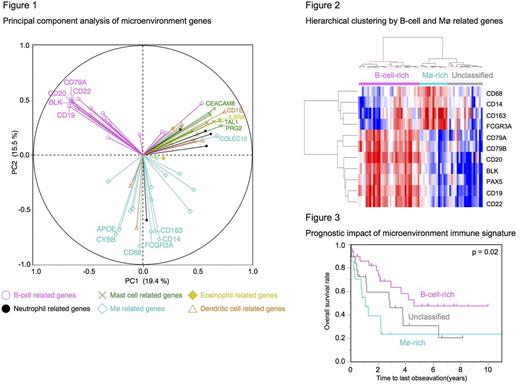Abstract
Peripheral T-cell Lymphoma Not Otherwise Specified (PTCL-NOS) is the largest group of peripheral T-cell lymphomas (PTCL) with dismal prognosis. PTCL-NOS does not correspond to any of the specifically defined entities of T-cell lymphoma in the World Health Organization classification and is referred to as the "waste-basket" category that contains heterogeneous disease entities. Its heterogeneity represents a major obstacle to development of standardized therapeutic strategies,, and therefore classification of this "waste-basket" diagnosis is necessary. Although previous studies tried to classify PTCL-NOS from the viewpoint of Cell-of-Origin (COO) of tumor cells by utilizing histopathologic methods or gene expression profiling, the prognostic impact of COO-based stratification still remains controversial. In addition, recent studies revealed the prognostic importance and the therapeutic potential of tumor-microenvironment in various types of cancers. These situations prompted us to investigate microenvironment profile of PTCL-NOS.
The aim of this study is to elucidate the microenvironment signatures of PTCL-NOS by gene expression profiling, and to establish a new stratification model. For this purpose, the expression levels of 770 genes related to phenotype and function of tumor T-cells and microenvironment immune cells (B-cells, macrophages (Mø), dendritic cells and granulocytes) were analyzed by employing nCounter system, digital RNA counting technology with high reproducibility for the measurement of even lowly-expressed genes from rare microenvironment components. Sixty-eight patients who were diagnosed as PTCL-NOS between 1993 and 2011 were included in this study. These patients were equally treated by anthracycline-based conventional chemotherapies,and the median survival period was 2.8 years (range, 0.2-11.0 years), which was comparable to historical controls.
To explore the classifier genes for PTCL-NOS, principal component analysis was performed and 2 distinct clusters of microenvironment-derived genes, B-cell (CD19, CD20, PAX5) and Mø (CD68, CD163) related genes, were identified (Figure 1). By hierarchical clustering analysis based on the expression levels of these genes, 68 PTCL-NOS patients were classified into three groups as B-cell-rich, Mø-rich and unclassified type (Figure 2). We visually confirmed that CD20+ B-cells and CD163+ Mø were enriched in the tumor tissues of B-cell-rich and Mø-rich type, respectively utilizing multiplexed fluorescent immunostaining (Perkin-Elmer, Mantra quantitative pathology workstation). More importantly, this microenvironment-based classification was significantly associated with prognosis: B-cell-rich type patients had better overall survival compared with Mø-rich patients (2-year overall survival: B-cell-rich type, 77.7%; Mø-rich type, 39.3%; others, 55.5%; p = 0.02) (Figure 3). We also validated the impact of these microenvironment signatures on the prognosis by analyzing published microarray datasets of 123 PTCL-NOS patients (GSE58445). Thus, B-cell-rich type patients were expected to respond to conventional chemotherapies and classified as favorable subtype.
We further investigated potential therapeutic targets for Mø-rich patients who were classified as unfavorable subtype, and found that gene expression levels of immune checkpoint molecules, such as PD-L1, PD-L2, TIM-3, LAG-3, IDO-1, were up-regulated in the Mø-rich type compared with the others (PD-L1, p < 0.01; PD-L2, p < 0.01; TIM-3, p < 0.01; LAG-3, p = 0.01; IDO-1, p < 0.01). Imaging analysis of Mø-rich type tissues with Mantra system revealed that PD-L1 was highly and exclusively expressed on the CD163+ Mø, suggesting that microenvironment Mø might negatively regulate tumor immunity via expression of immune-checkpoint molecules and that Mø-rich type patients were expected to respond to immunotherapeutic agents including immune checkpoint inhibitors.
In conclusion, our findings collectively suggest that tumor microenvironment signature has significant prognostic impact, and novel microenvironment-based stratification model will contribute to the development of optimal therapeutic strategies for PTCL-NOS patients.
No relevant conflicts of interest to declare.
Author notes
Asterisk with author names denotes non-ASH members.


This feature is available to Subscribers Only
Sign In or Create an Account Close Modal